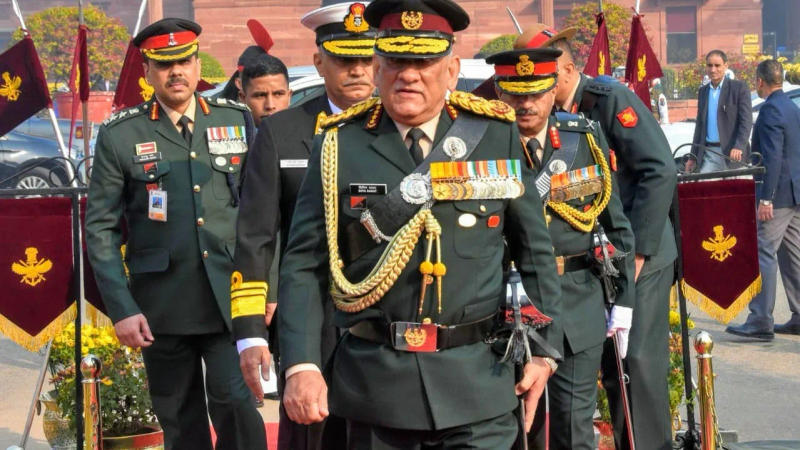Published 14:18 IST, December 8th 2023
Remembering India’s first CDS, General Bipin Rawat and his vision of theaterisation
From early military career contributions to transformative role as CDS, Gen Rawat's vision for integrated armed forces lives on.

In a poignant moment that echoes through the corridors of India's military history, the nation once again reflects on the life and legacy of General Bipin Rawat, the distinguished four-star general and India's inaugural Chief of Defence Staff (CDS). Two years have passed since the tragic helicopter crash that claimed the lives of General Rawat, his wife, and members of his staff, yet the indelible mark he left on the Indian Armed Forces endures.
General Bipin Rawat's legacy lives on in the ongoing efforts to implement the structural changes he championed. The creation of theatre commands, a concept he ardently endorsed, remains a work in progress, reflecting his enduring influence on India's defence architecture.
Military career rooted in strategic contributions and operational excellence
General Bipin Rawat, born on March 16, 1958, in Pauri, Uttarakhand, hailed from a military lineage. His father, Lieutenant General Lakshman Singh Rawat, set the stage for a career that would span over four decades. Commissioned into the 5th battalion, the 11 Gorkha Rifles, on December 16, 1978, the young officer embarked on a journey that would shape the future of India's military leadership.
Educated at the National Defence Academy and the Indian Military Academy, General Rawat's early career included a significant chapter during the 1987 Sino-Indian skirmish in the Sumdorong Chu valley, where his battalion confronted the Chinese People's Liberation Army.

General Rawat's rise through the ranks was marked by strategic contributions and operational excellence. After instructional duties at the Indian Military Academy, he gained extensive experience in high-altitude warfare and counter-insurgency operations. His leadership roles included commanding a company in Uri, Jammu and Kashmir, and later, the 5th battalion, the 11 Gorkha Rifles, along the Line of Actual Control at Kibithu.
The trajectory of General Rawat's career ascended to higher echelons as he assumed the role of General Officer Commanding-in-Chief Southern Command in 2016. Prior to this, he played a pivotal role as the Vice Chief of the Army Staff and Chairman of the Chiefs of Staff Committee from September to December 2019.
Architect of military transformation as CDS
January 1, 2020, marked a historic moment for the Indian Armed Forces with the appointment of General Bipin Rawat as the first Chief of Defence Staff. In this transformative role, he spearheaded initiatives aimed at enhancing jointness and integration among the three services. General Rawat's vision included the creation of theatre commands to optimize military capabilities and streamline operations, a paradigm shift in India's defence structure.
The Chief of Defence Staff serves as the professional head and permanent Chairman of the Chiefs of Staff Committee (COSC) of the Indian Armed Forces. Holding the highest-ranking uniformed position in the military, the CDS functions as the chief military adviser to the Minister of Defence. Additionally, the CDS leads the Department of Military Affairs, a crucial component overseeing military strategy and coordination.

The role was conceived to improve coordination, tri-service effectiveness, and overall integration of combat capabilities across the armed forces. Meanwhile, the Integrated Defence Staff (IDS) plays a pivotal role in fostering coordination and prioritization across various branches of the Indian Armed Forces. Comprising representatives from the Army, Navy, Air Force, Ministry of External Affairs, Defence Research and Development Organisation, Ministry of Defence, and Ministry of Finance, the IDS ensures seamless collaboration.
The Chief of Integrated Defence Staff, along with Deputy Chiefs, leads the IDS, contributing to strategic decision-making and coordination. The establishment of the Chief of Defence Staff and the IDS underscores India's commitment to bolstering its defence capabilities through enhanced integration and strategic coordination.
Tragic end in helicopter crash
On December 8, 2021, tragedy struck as General Rawat, along with his wife and members of his staff, met with a fatal accident. The Indian Air Force Mil Mi-17 helicopter they were aboard crashed near Coonoor, Nilgiris district, en route from Sulur Air Force Base to the Defence Services Staff College, Wellington. The crash site, tragically, was a mere 10 kilometres from the intended destination.
The aftermath saw the Indian military and the nation mourning the loss of a visionary leader. Group Captain Varun Singh, General Rawat's liaison officer, initially survived the incident but succumbed to injuries on December 15, 2021.
General Bipin Rawat's legacy lives on in the ongoing efforts to implement the structural changes he championed. The creation of theatre commands, a concept he ardently endorsed, remains a work in progress, reflecting his enduring influence on India's defence architecture.

As the nation observes the 2nd anniversary of General Rawat's passing, the solemn ceremonies and tributes serve as a poignant reminder of a leader whose contributions transcended his lifetime. The tricolour that draped his final resting place at Brar Square Crematorium in Delhi Cantonment on December 10, 2021, symbolized a nation's gratitude for a lifetime of service. India continues to honour General Bipin Rawat, not just in remembrance but in the commitment to fulfil the vision he had for a stronger, integrated, and resolute armed forces.
Updated 14:38 IST, December 8th 2023




